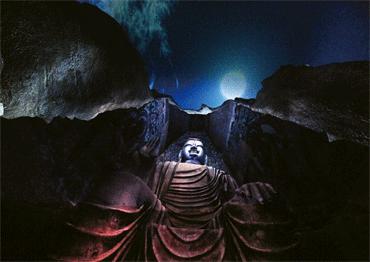The Lo Archive is the most systematic and complete photo documentation of Dunhuang Grottoes before 1949. It covers almost all the accessible caves and offers valuable glimpses into Dunhuang’s history.
In 1943, as the National Dunhuang Art Institute (now the Dunhuang Academy) prepared to open, founder Chang Shuhong invited James Lo, a photojournalist from the Central News Agency, to take photographic records of Dunhuang.
That same year, as the War of Resistance Against Japanese Aggression raged on (1931- 1945), James and Lucy Lo spent 18 months in Dunhuang shooting their unprecedented collection of photos.
Out in the remote desert, many caves were inaccessible. “Prior to embarking on their journey to Dunhuang, they had to plan what supplies they would need and buy all of it – again, no small feat during a war,” Ching told NewsChina. “They also faced many unknowns, such as how they were going to arrange for transportation, what they’d find in Dunhuang, preparing enough film stock and chemicals and how were they going to live.”
Lucy Lo told Ching stories from their time at the site. To light the dark caves, James Lo carefully placed mirrors and white screens to funnel sunlight from the entrance. To stretch their limited supply of film, he sometimes shot two different images on a single negative. James also diverted a nearby mountain stream with bamboo piping to a tank fashioned from porcelain fragments to develop the negatives on-site.
Despite the harsh conditions, the Los shot almost all the caves they could access. Besides panoramas of entire cave murals, they took close-ups of individual Bodhisattvas and other images. “The Lo Archive holds great value not only for its preservation of the historical images of the exteriors of the Dunhuang caves, but also for comparative analysis of the caves’ contents,” Dr. Zhao Shengliang, Party secretary of the Dunhuang Academy, said in a 2014 article in Chinese journal Dunhuang Research.
Zhao cataloged the Lo Archive: 2,872 photos from 327 Mogao Caves with 146 exterior photos, and 187 photos from 21 Yulin Caves with 16 exterior photos.
Additionally, there are photos of local people, cultural relics surrounding Mogao, Dunhuang and the nearby Crescent Moon Spring.
In the second half of 1944, the Los returned to China’s wartime capital of Chongqing, where they developed photographs for exhibitions at the National Dunhuang Art Institute in Nanjing and Shanghai. Because of the war, they moved from Chongqing to Nanjing and then to Taiwan before finally emigrating to the US in the early 1960s.
Lo sought opportunities to publish his photos, but was unsuccessful in his lifetime.
Through efforts by generations of Chinese and Western scholars, the Lo Archive was finally compiled into the book series Visualizing Dunhuang: The Lo Archive Photographs of the Mogao and Yulin Caves published by Princeton University Press in June 2021. It was released in China in September the same year.
“In 2008, the Tang Center embarked upon a project to publish the archive of James and Lucy Lo’s 1943-1944 photographs of the Mogao and Yulin Caves near the ancient trade center of Dunhuang, along with a set of scholarly essays. In the decade that followed, the project underwent many changes,�� the preface reads.

 Old Version
Old Version




